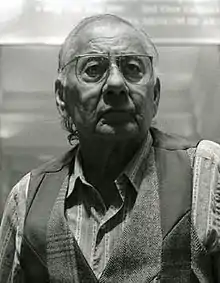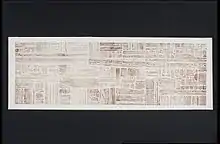George Morrison (artist)
George Morrison (1919 – April 17, 2000) was an American landscape painter and sculptor. His Indian name was Wah Wah Teh Go Nay Ga Bo (Standing In the Northern Lights).[1]
George Morrison | |
|---|---|
 | |
| Born | 1919 Chippewa City, Cook County, Minnesota |
| Died | 2000 (aged 80–81) Red Rock, near Grand Marais, Minnesota |
| Nationality | Ojibwe |
| Occupation | Abstract Expressionist Painter and Sculptor |
| Spouse(s) |
|
| Children | Briand Mesaba |
Morrison is associated with the individualist modern art movement of artists who wished to be known apart from contemporary movements or their backgrounds.[2] He is well known for wood collage sculptures and for the landscape paintings he preferred.
Early life and education
Morrison is of Ojibwe ancestry. He was born in 1919 in Chippewa City, Cook County, Minnesota near the Grand Portage Indian Reservation. Morrison was a member of the Grand Portage Band of Ojibwe.[3] Morrison was one of twelve children in a poor household. His father worked as a trapper and used his fluent knowledge of the Chippewa language to interpret court proceedings. Morrison briefly attended a Native American boarding school in Hayward, Wisconsin.[4] Due to poor health, Morrison returned to Minnesota and was for a time a Native American sanatorium in Onigum, Minnesota and the Gillette State Hospital for Crippled Children in St. Paul.[3]
He attended Grand Marais High School, graduating in 1938, and then the Minnesota School of Art, now the Minneapolis College of Art and Design, graduating in 1943.[1]
Having been chosen to receive the Ethel Morrison Van Derlip Traveling Scholarship, Morrison studied at the Art Students League from 1943 to 1946 in New York City, where he became part of a circle of abstract expressionists and was exposed to artistic styles such as cubism and surrealism.[4]
In 1947 Morrison took a teaching position at the Cape Ann Art School; the following summer Morrison and Albert Kresch took over the school and renamed it the Rockport Art School.[3]
In 1952 after receiving a Fulbright scholarship he studied in Paris at the Ecole des Beaux-Arts and Antibes,[1] and at the University of Aix-Marseilles. In 1953 he was awarded a John Hay Whitney Fellowship and moved to Duluth, Minnesota.[3]
Later life
He lived in Duluth, Minnesota for years and then moved back to New York City in 1954 where he became acquainted with prominent American expressionists: Willem de Kooning, Franz Kline and Jackson Pollock.[1]
He then taught in Minneapolis, Duluth, Dayton, Ohio at the Dayton Art Institute, Ithaca (Cornell University), Pennsylvania (Penn State), Iowa State Teachers College, and New York City.[1][3]
From 1963-1970 Morrison taught at the Rhode Island School of Design.[1]
In 1969 he was awarded an Honorary Master of Fine Arts at the Minneapolis College of Art and Design.
Beginning in 1970 he taught American Indian studies and art at the University of Minnesota until he retired in 1983.[1]
In 1999 Morrison was awarded the title of Master Artist by the Eiteljorg Fellowship for Native American Fine Art.[5]
Personal life
Morrison met his first wife, Ada Reed in Provincetown, Massachusetts. The two were married in 1948. Morrison and Reed divorced at an unknown date. [3]
While teaching at the Dayton Art Institute Morrison met his second wife, Hazel Belvo. The two would have one child together, Briand Mesaba; Belvo had two children from a previous marriage.[3]
He lived in a renovated church in Saint Paul, Minnesota with Briand and Belvo,[1] another Minnesota artist, who taught at Minneapolis College of Art and Design and Saint Paul Academy and is known for her series of pieces based on the Witch Tree.
During the mid-1970s, they acquired land near Grand Portage, Minnesota on Lake Superior, which they named Red Rock.[1] This became their home and studio.[1] He and Belvo divorced in 1991 but remained friends. Morrison suffered some life-threatening illnesses, including being diagnosed with Castleman's disease in 1984, but kept on working until he died at Red Rock in April 2000.[1][3]
Art
Morrison learned the Euro-American traditional methods of realism during his time at the Minneapolis School of Art. However, during his time at the Art Students League in New York City Morrison's style became more modernist and abstract.[3]
Morrison acknowledged a variety of influences in his art, including cubism, surrealism, and abstract expressionism. In his drawings and paintings, Morrison used abstract forms to represent organic figures. Morrison commonly used landscapes and mosaic patterns in his paintings. For his wood collages, Morrison would gather driftwood along shorelines. Morrison's totem works were formally designed and glued to a piece of plywood that was the backbone of the piece. [4]
In addition to European and North American artistic movements, Morrison also was inspired by pre-Columbian art and architecture and Australian Aboriginal art.[5]
Selected solo exhibitions

- 1948-1960: Grand Central Moderns Gallery - New York City, NY
- 1949: Hart Gallery - Duluth, MN
- 1950: Ed Weiner Gallery - Provincetown, MA
- 1954: University of Minnesota - Duluth, MN
- 1955: Shorter College - Rome, GA
- 1957: University of Georgia - Athens, GA
- 1960: Dayton Art Institute - Dayton, OH
- 1961: State College of Iowa (now known as the University of Northern Iowa) - Cedar Falls, IA
- 1962: Cornell University - Ithaca, NY; Antioch College - Yellow Springs, OH
- 1967: Academy of Fine Arts - Lynchburg, VA
- 1973-1974: George Morrison: Drawings, traveling exhibition: Walker Art Center - Minneapolis, MN; Heard Museum - Phoenix, AZ; Art Museum of South Texas - Corpus Christi, TX; Amon Carter Museum of Western Art (now known as the Amon Carter Museum of American Art) - Fort Worth, TX
- 1976: Minneapolis Institute of Arts - Minneapolis, MN; Bethel College - Saint Paul, MN
- 1978: Macalester College - Saint Paul, MN; University of Wisconsin–Stout - Menomonie, WI; Carl N. Gorman Museum, University of California - Davis, CA
- 1983: University of Minnesota - University Art Museum, Minneapolis, MN
- 1984: "George Morrison: Paper Collages," Tweed Museum of Art - University of Minnesota, Duluth, MN;
- 1987-1988: "Horizon: Small Painting Series 1980-87," Minnesota Museum of American Art - St. Paul, MN
- 1990: "Standing in the Northern Lights: George Morrison, A retrospective," circ., Tweed Museum of Art - University of Minnesota, Duluth and the Minnesota Museum of Art, St Paul, MN.
- 1998: "Morrison's Horizon," Minneapolis Institute of Arts, Minnesota Artists Exhibition Program, Minneapolis, MN
- 2010: "From the Minnesota Museum of American Art", Bockley Gallery, Minneapolis, Minnesota
- 2013–2014: Modern Spirit: The Art of George Morrison, traveling solo retrospective curated by the Minnesota Museum of American Art - Plains Art Museum, Fargo, ND; National Museum of the American Indian, George Gustav Heye Center; Eiteljorg Museum of American Indians and Western Art; Heard Museum; Minnesota History Center
Notes
- Riddle, Mason (January 30, 2010). "An appreciation of George Morrison, a brilliant local artist who hung out with Jackson Pollock, who taught at Cornell and RISD, and who happened to be Native". Twin Cities Daily Planet. Retrieved January 30, 2010.
- Wade, Edwin; Strickland, Rennard (1981). Magic Images: Contemporary Native American Art. Philbrook Art Center and University of Oklahoma Press. p. 4.
- Anthes, Bill (2006). Native Moderns: American Indian Painting, 1940-1960. Duke University Press.
- Katz, Jane, ed. (1980). This Song Remembers: Self-Portraits of Native Americans in the Arts. Boston: Houghton Mifflin Company. pp. 54–60.
- Andrew White, Mark, ed. (2012). The James T. Bialac Native American Art Collection. University of Oklahoma Press. p. 114.
References
- H. H. Arnason, History of Modern Art: Painting, Sculpture, Architecture, Photography. 3rd ed. New York: Harry N. Abrams, 1986.
- Joseph Bruchac, The Heye Center Opens in Manhattan with Three Exhibitions of Native Arts, (Smithsonian v25 n7 p. 40–49 Oct 1994) ISSN 0037-7333 OCLC 93642777
- William Rubin, "Arshile Gorky, Surrealism and the New American Painting," In Henry Geldzahler, New York painting and sculpture: 1940–1970, (New York, Dutton 1969.) OCLC 45703 pp. 372–402
- W. Jackson Rushing, Native American art and the New York avant-garde : a history of cultural primitivism, (Austin : University of Texas Press, 1995.) ISBN 0-292-75547-3, ISBN 978-0-292-75547-5
- Marika Herskovic, American Abstract Expressionism of the 1950s An Illustrated Survey, (New York School Press, 2003.) ISBN 0-9677994-1-4
- Smithsonian Institution Research Information System; Archival, Manuscript and Photographic Collections, George Morrison
Further reading
- W. Jackson Rushing III, Modern Spirit: The Art of George Morrison. Norman: University of Oklahoma, 2013. ISBN 978-0-806-14393-4.
External links
- George Morrison in MNopedia, the Minnesota Encyclopedia
- Minneapolis Institute of Arts (n.d.). "works of George Morrison". Archived from the original on 2007-09-30. Retrieved 2007-01-19.
- Ask ART (2004). "George Morrison". Retrieved 2007-01-19.
- Archuleta, Margaret, The Heard Museum, The White House (n.d.). "Twentieth Century American Sculpture - Exhibit VI: Red Totem (1980)". Retrieved 2007-01-19.CS1 maint: multiple names: authors list (link)
- The Minnesota Museum of American Art (n.d.). "Modern Spirit: The Art of George Morrison". Archived from the original on 2013-10-20. Retrieved 2013-10-09.
- Art and Life of George Morrison: A "Beyond The Book" Special. PBS. Retrieved April 5, 2015.
- George Morrison, along with writer/editor Margot Fortunato Galt, discuss a book about his art, Turning the Feather Around, published by Minnesota Historical Society Press. They are interviewed by writer Joanne Hart in George’s studio along Lake Superior on the Grand Portage Reservation. Northern Lights TV Series #409 (1998) [https://reflections.mndigital.org/catalog/p16022coll38:93#/kaltura_video] or on YouTube: [https://www.youtube.com/watch?v=n8MXPuf5h7Y]